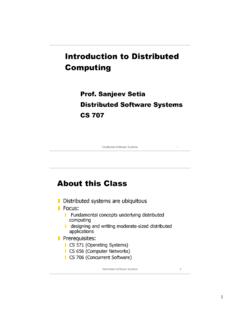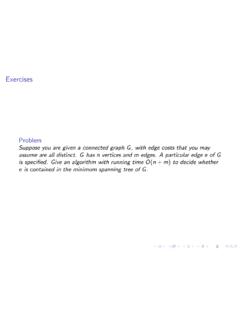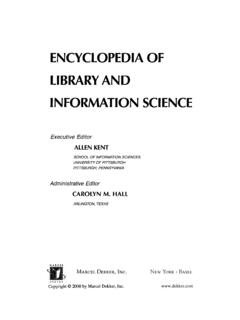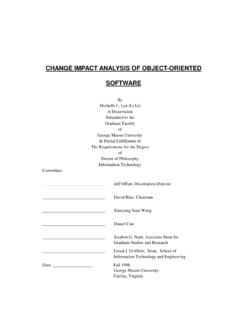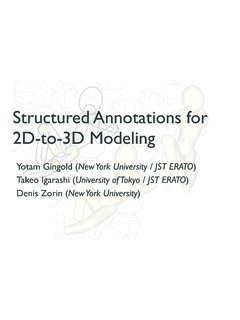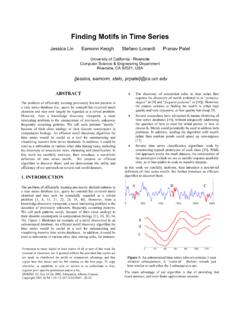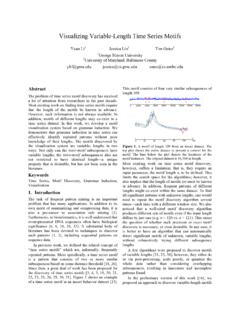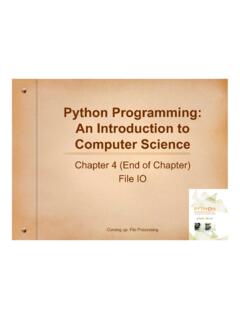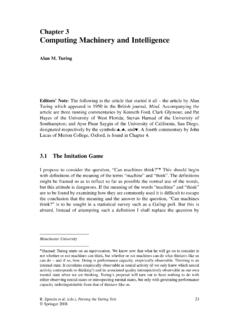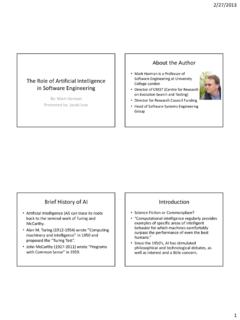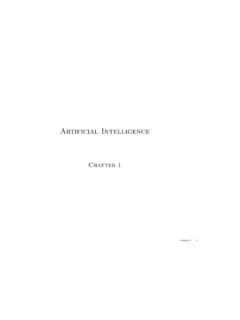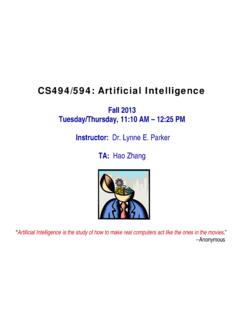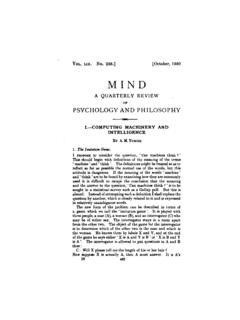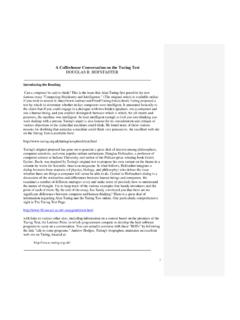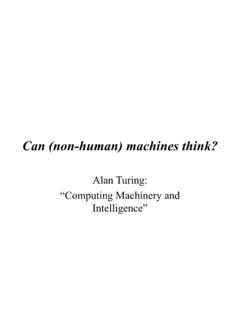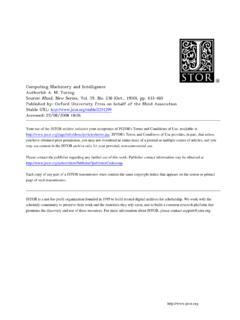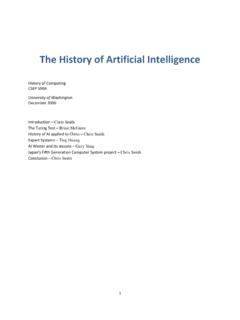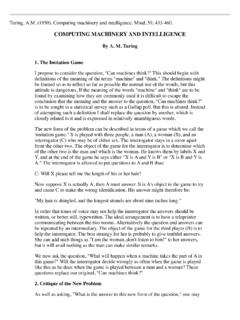Transcription of c Stuart Russell and Peter Norvig, 1998
1 Artificial IntelligenceChapter 1 AIMA Slidesc Stuart Russell and Peter Norvig, 1998 Chapter 11 Outline}Course overview}What is AI?}Abriefhistory}The state of the art}Introduction to symbolic programmingAIMA Slidesc Stuart Russell and Peter Norvig, 1998 Chapter 12 AdministriviaJana KoseckaO ce: 417 ST II, e-mail: ce hours: Thursday 2-4pm or by appt., 417 ST IITA: Cristian LevcoviciClass home page: ~kosecka/cs580/for lecture notes, assignments, exams, grading, o ce hours, 0 (lisp primer) due January 25 Book: Russell and Norvig Arti cial intelligence : A Modern ApproachRead Chapters 1 and 2 for this week's materialAIMA Slidesc Stuart Russell and Peter Norvig, 1998 Chapter 13 Course overview}intelligent agents}search and game-playing}logical systems}planning systems}uncertainty|probability and decision theory}learning}language}perception}robo tics}philosophical issuesAIMA Slidesc Stuart Russell and Peter Norvig, 1998 Chapter 14 What is AI?
2 [The automation of] activities that weassociate with human thinking, activ-ities such as decision-making, problemsolving, (Bellman, 1978) The study of mental faculties throughthe use of computational models (Charniak+McDermott, 1985) The study of how to make computersdo things at which, at the moment, peo-ple are better (Rich+Knight, 1991) The branch of computer science thatis concerned with the automation of in-telligent behavior (Luger+Stubblefield,1993)Views of AI fall into four categories:Thinking humanlyThinking rationallyActing humanlyActing rationallyExamining these, we will plump for acting rationally (sort of)AIMA Slidesc Stuart Russell and Peter Norvig, 1998 Chapter 15 Acting humanly: The Turing testTuring (1950) \ computing machinery and intelligence ":}\Can machines think?
3 " !\Can machines behave intelligently?"}Operational test for intelligent behavior: the Imitation GameAI SYSTEMHUMAN? HUMANINTERROGATOR}Predicted that by 2000, a machine might have a 30% chance offooling a lay person for 5 minutes}Anticipated all major arguments against AI in following 50 years}Suggested major components of AI: knowledge, reasoning, languageunderstanding, learningProblem: Turing test is not reproducible, constructive,oramenable to mathematical analysisAIMA Slidesc Stuart Russell and Peter Norvig, 1998 Chapter 16 Thinking humanly: Cognitive Science1960s \cognitive revolution".
4 Information-processing psychology replacedprevailing orthodoxy of behaviorismRequires scienti c theories of internal activities of the brain{ What level of abstraction? \Knowledge" or \circuits"?{ How to validate? Requires1) Predicting and testing behavior of human subjects (top-down)or 2) Direct identi cation from neurological data (bottom-up)Both approaches (roughly, Cognitive Science and Cognitive Neuroscience)are now distinct from AIAIMA Slidesc Stuart Russell and Peter Norvig, 1998 Chapter 17 Thinking rationally: Laws of ThoughtNormative(or prescriptive) rather than descriptiveAristotle: what are correct arguments/thought processes?}}
5 Several Greek schools developed various forms of logic:notationand rules of derivationfor thoughts;may or may not have proceeded to the idea of mechanizationDirect line through mathematics and philosophy to modern AIProblems:1) Not all intelligent behavior is mediated by logical deliberation2) What is the purpose of thinking? What thoughts should I have?AIMA Slidesc Stuart Russell and Peter Norvig, 1998 Chapter 18 Acting rationallyRationalbehavior: doing the right thingThe right thing: that which is expected to maximize goal achievement,given the available informationDoesn't necessarily involve thinking| , blinking reflex|butthinking should be in the service of rational actionAristotle (Nicomachean Ethics).
6 Every art and every inquiry, and similarly every actionand pursuit, is thought to aim at some goodAIMA Slidesc Stuart Russell and Peter Norvig, 1998 Chapter 19 Rational agentsAn agentis an entity that perceives and actsThis course is about designing rational agentsAbstractly, an agent is a function from percept histories to actions:f:P !AFor any given class of environments and tasks, we seek theagent (or class of agents) with the best performanceCaveat: computational limitations make perfect rationality unachievable!design best programfor given machine resourcesAIMA Slidesc Stuart Russell and Peter Norvig, 1998 Chapter 1 10AI prehistoryPhilosophylogic, methods of reasoningmind as physical systemfoundations of learning, language, rationalityMathematics formal representation and proofalgorithmscomputation, (un)decidability, (in)tractabilityprobabilityPsychologyada ptationphenomena of perception and motor controlexperimental techniques (psychophysics, etc.)
7 Linguisticsknowledge representationgrammarNeuroscience physical substrate for mental activityControl theory homeostatic systems, stabilitysimple optimal agent designsAIMA Slidesc Stuart Russell and Peter Norvig, 1998 Chapter 1 11 Potted history of AI1943 McCulloch & Pitts: Boolean circuit model of brain1950 Turing's \ computing machinery and intelligence "1952{69 Look, Ma, no hands!1950sEarly AI programs, including Samuel's checkers program,Newell & Simon's Logic Theorist, Gelernter's Geometry Engine1956 Dartmouth meeting: \Arti cial intelligence " adopted1965 Robinson's complete algorithm for logical reasoning1966{74 AI discovers computational complexityNeural network research almost disappears1969{79 Early development of knowledge-based systems1980{88 Expert systems industry booms1988{93 Expert systems industry busts.}}}}}
8 \AI Winter"1985{95 Neural networks return to popularity1988{Resurgence of probabilistic and decision-theoretic methodsRapid increase in technical depth of mainstream AI\Nouvelle AI": ALife, GAs, soft computingAIMA Slidesc Stuart Russell and Peter Norvig, 1998 Chapter 1 12 State of the artWhich of the following can be done at present?}Play a decent game of table tennis}Drive along a curving mountain road}Drive in the center of Cairo}Play a decent game of bridge}Discover and prove a new mathematical theorem}Write an intentionally funny story}Give competent legal advice in a specialized area of law}Translate spoken English into spoken Swedish in real timeAIMA Slidesc Stuart Russell and Peter Norvig, 1998 Chapter 1 13
